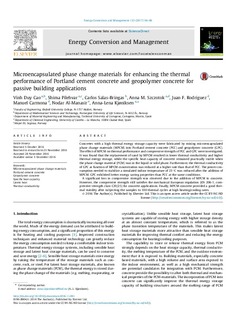Microencapsulated phase change materials for enhancing the thermal performance of Portland cement concrete and geopolymer concrete for passive building applications
Cao, Vinh Duy; Pilehvar, Shima; Salas Bringas, Carlos; Szczotok, Anna; Rodriguez, Juan F.; Carmona, Manuel; Al-Manasir, Nodar; Kjøniksen, Anna-Lena
Journal article, Peer reviewed
Published version
Permanent lenke
http://hdl.handle.net/11250/2476319Utgivelsesdato
2017Metadata
Vis full innførselSamlinger
Sammendrag
Concretes with a high thermal energy storage capacity were fabricated by mixing microencapsulated
phase change materials (MPCM) into Portland cement concrete (PCC) and geopolymer concrete (GPC).
The effect of MPCM on thermal performance and compressive strength of PCC and GPC were investigated. It was found that the replacement of sand by MPCM resulted in lower thermal conductivity and higher thermal energy storage, while the specific heat capacity of concrete remained practically stable when the phase change material (PCM) was in the liquid or solid phase. Furthermore, the thermal conductivity of GPC as function of MPCM concentration was reduced at a higher rate than that of PCC. The power consumption needed to stabilize a simulated indoor temperature of 23°C was reduced after the addition of MPCM. GPC exhibited better energy saving properties than PCC at the same conditions.
A significant loss in compressive strength was observed due to the addition of MPCM to concrete.
However, the compressive strength still satisfies the mechanical European regulation (EN 206-1, compressive strength class C20/25) for concrete applications. Finally, MPCM-concrete provided a good thermal stability after subjecting the samples to 100 thermal cycles at high heating/cooling rates.
